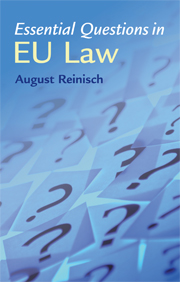Book contents
- Frontmatter
- Contents
- List of abbreviations
- Preface
- 1 History of European integration
- 2 The institutional framework
- 3 The making of Community law
- 4 The effect of Community law
- 5 Judicial control within the Community
- 6 Protecting fundamental rights within the Community
- 7 The free movement of goods
- 8 The free movement of persons
- 9 EC competition law
- 10 Selected Community policies
- 11 The EC and the EU as international actors
- Index
4 - The effect of Community law
Published online by Cambridge University Press: 05 June 2012
- Frontmatter
- Contents
- List of abbreviations
- Preface
- 1 History of European integration
- 2 The institutional framework
- 3 The making of Community law
- 4 The effect of Community law
- 5 Judicial control within the Community
- 6 Protecting fundamental rights within the Community
- 7 The free movement of goods
- 8 The free movement of persons
- 9 EC competition law
- 10 Selected Community policies
- 11 The EC and the EU as international actors
- Index
Summary
Community law, that is, the treaties and secondary law made according to the different legislative procedures, is directly applied and enforced by EU institutions only exceptionally. The most important exception relates to the Commission's power to enforce EC competition law (Articles 81 and 82 TEC, as well as Regulation 17, now Regulation 1/2003). In addition, the Commission also exercises other treaty-based or delegated powers.
Most Community law, however, is applied and enforced in a decentralised fashion by national authorities. As a rule, the courts and administrative agencies of the Member States apply and enforce ‘directly applicable’ EC law as well as nationally implemented non-directly applicable Community law.
This chapter will explain how the European Court of Justice has made Community law ever more effective by declaring not only regulations, but also Treaty provisions and provisions in directives – under certain circumstances – directly applicable/effective in the legal systems of the Member States.
What do we understand by ‘direct effect’?
A norm of international or supranational law is said to have ‘direct effect’ if it is sufficiently clear, precise and unconditional to be invoked before national courts or administrative agencies.
In EC law ‘direct effect’ may attach to provisions of the Treaty, of international agreements of the Community and secondary legislation, including, under certain circumstances, even to directives.
- Type
- Chapter
- Information
- Essential Questions in EU Law , pp. 50 - 67Publisher: Cambridge University PressPrint publication year: 2009



